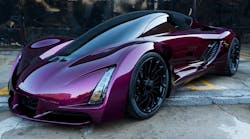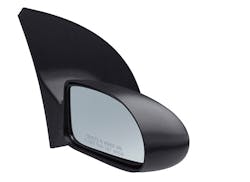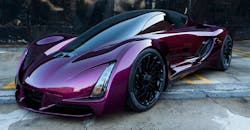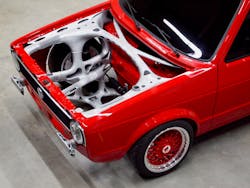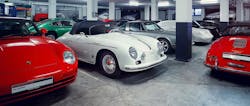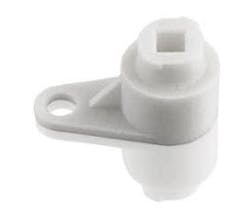3D printing, also called additive manufacturing, has been growing in the automotive industry over the years. While some companies work on integrating every benefit of 3D printing into a completely new design, other companies are looking for the low-hanging fruit to dip their toe in as they target specific parts that can be printed within the current vehicle designs. This article will review how 3D printing has been affecting the automotive market, and what some companies are doing to capture its benefits.
Prototyping
While this sounds like everyone is already using 3D printing for prototyping, the hype doesn’t necessarily match real life. From an interview in 2016, Scott Dunham, vice president of research for SmarTech Publishing, had this to say: “For example, the vast majority of the current deployments in the industry are around rapid prototyping for automobile design to cut down lead times on designing new models or revisions. Although with only around 15% to 20% penetration currently, we estimate a lot of room to grow in rapid prototyping.”
However, as access and knowledge of 3D printing are expanding, the cost of 3D printers is simultaneously dropping. In addition, engineers are starting to realize that they might not need a million-dollar machine to accelerate prototype iterations. Low-cost 3D printers are growing up and giving engineers the ability to test a design for form and fit. Sometimes just having a model or part in the engineer’s hands will show mistakes or value-added alterations.
When it comes to 3D-printed prototypes, if you do need an expensive machine, the costs for them are coming down, too. Firms like Carbon certainly are talking as though they have an eye on production parts, but for now it's not in the same league as powder-bed fusion or extrusion.
Still, these technologies might be the ultimate prototyping tools for the industry thanks to simulated thermoplastics, adjustable material properties, or multi-material printing—like in material jetting or Polyjet—along with the great aesthetics. Currently, many high-strength prototypes and parts use a powder bed process to produce higher-strength materials like nylon 12 and various metals. These machines are often expensive, leaving many prototyping to third party services. But that may change as metal printers are dramatically being reduced in cost, new plastics are developed with higher strengths, and some polymers are adding carbon fiber.
Desktop Metals and Markforged have reduced the cost of printing with some materials. Desktop Metals is using the powder bed process, but uses binder jetting and a built in furnace to produce dense parts. This means you don’t have to have the cost of a laser or the electric to operate it, and you can drop binder agents much faster than a single laser can sinter.
Markforge is focusing on using multiple materials. The Mark Two is able to produce continuous carbon fiber parts. Citing one example, Markforge says this technique makes parts 20% stronger and 40% stiffer than traditional ABS parts.
Manufacturing
These new technologies are also increasing production time. This moves 3D printing closer to full production parts.
This passenger side mirror mount was manufactured using FDM technology in ASA material. (Courtesy of Stratasys Direct Manufacturing)
In order to take advantage of 3D printing in automobiles, there are groups like the PSA Group and 3-PRINT that are working on radical design concepts. The PSA Group—a European car manufacturer—is looking to integrate an entirely new design and manufacturing platform developed around 3D printing through Divergent3D (Divergent 3D claims to have made the first 3D printed super car).
The Blade is made from a sustainable platform. Some of the body parts are metal 3D-printed junctions where carbon fiber rods slide into for a quick custom design and assembly. The Blade is 700 hp, goes 0-60 mph in 2.5 sec., and weighs 1,400 lb.
3-PRINT was a partnership to generate a new frontend of a classic to show off what 3D printing can do. The partnership (that didn’t include Volkswagen) developed a structural front end of a classic Volkswagen Caddy that included passive cooling. Air channels were designed to cool batteries and braking systems. In addition, safety features and fluid storage are all built into the 3D-printed front end.
3i-PRINT is a partnership project with Altair, APWORKS, csi entwicklungstechnik, EOS GmbH, GERG, and Heraeus that used the front-end structure of a classic Volkswagen VW Caddy to demonstrate the full potential of organic load-bearing structures within the automotive industry.
Other players are taking a somewhat more cautious approach. They are simply printing some existing noncritical parts, rather than injection molding them, because of some cost and lead-time savings in relatively safe luxury and high-performance models. While this can be done on new cars, this will change the automotive aftermarket.
Porsche Classic recently identified 52,000 parts that, if possible to manufacture economically, would help keep its classic on the road. In a press release Porsche says, “If a certain spare part is no longer in stock or stock is dwindling, it is reproduced using the original tools. For larger quantities, production may require the use of new tools. However, ensuring the supply of spare parts that are only required in very limited numbers sometimes poses a major challenge, even for the experts. Producing small batches using new tools would be largely inefficient. Before embarking on a project to produce a particular component, Porsche Classic always evaluates various manufacturing processes.”
3D printing is a godsend for the Porsche 959, as the car parts selected (such as the release lever for the clutch) are no longer available. This component made from grey cast iron is subject to very high-quality requirements, but is in very low demand—not least because only 292 of these super sports cars were ever produced.
Additive manufacturing is an alternative for these aftermarket parts. Due to the consistently positive results achieved to date, Porsche is currently manufacturing eight additional parts using 3D printing. The ones in question are steel and alloy parts produced using the selective laser melting (SLM) process, along with plastic components manufactured using a selective laser sintering (SLS). Porsche Classic is currently testing whether 3D printing is suitable for the production of a further 20 components. Using three-dimensional design data or a 3D scan of the component is sufficient to start production. The components can be produced on demand if needed, thereby eliminating tool and storage costs.
This spare part is the crank of a Porsche 964 made by Porsche Classic 3D printing.
With some vehicle lines pumping out a finish product every minute or few, 3D printing might struggle to keep up. Until a more radical fully integrated design is worked out, 3D printing will need to increase its speed. However, not every vehicle is as high-volume as others.
Manufacturers of motorcycles, all-terrain vehicles, jet skis, and more have a lower production volume and often smaller size compared to cars and trucks. This makes them prefect for 3D printing. GKN—a powder metallurgy company—has already designed parts for car and motorcycles using traditional powder metallurgy, and predicts many of these parts will see a benefit with 3D printing.
Current Biggest Impact
Today, 3D printing is working towards the lowest-hanging fruit: additive tooling. This can be used in prototyping or manufacturing, and can drastically reduce lead times and costs. Printed tools might represent the biggest area of low-hanging fruit for moving adoption of 3D printing forward in the industry.
Volkswagen has claimed to be saving thousands of dollars, and many labor hours, by having the ability to print gages and fixtures. Often when a new tool is needed, it is custom and would take an outside company or department to make it. This create lag in the system. With 3D printing , VW can have people from the shop floor suggest something that might make their lives easier and do their job faster. Then with a low-cost Ultimaker 3D printer (Ultimaker is the brand VW is using, but in general, any low-cost printer will suffice), that employee can be holding the time saving tool in their hand sometimes in the same day.
